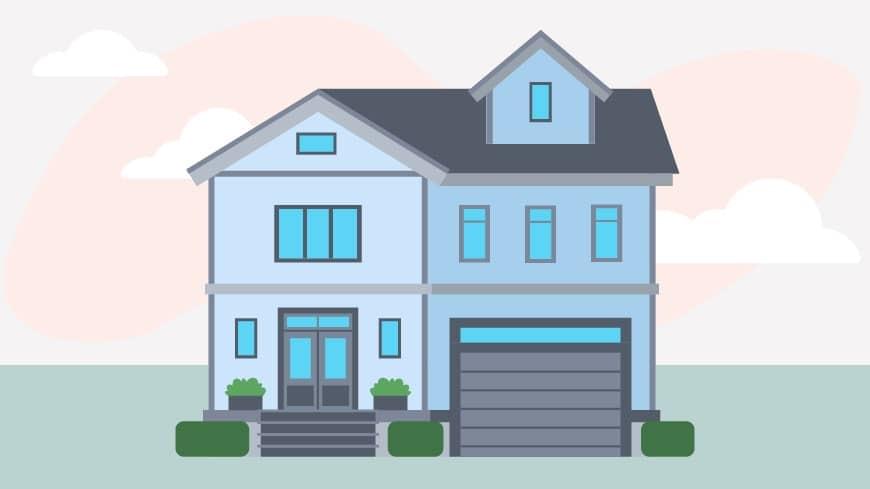What Is the Average Monthly Mortgage Payment?

If you’re thinking about buying a home, you’ve probably wondered, “how much will my monthly mortgage payment be?” It’s one of the biggest questions every home buyer has, and for good reason.
Your mortgage payment isn’t just about paying off the loan; it also covers things like property taxes, insurance, and more. The good news? Once you understand how everything adds up, it’s easier to plan your budget and feel confident in your next move.
Want to see how much house you can afford? Visit Rate to get started with Same Day Mortgage. You could be one step closer to finding your dream home.
What Is the Average Monthly Mortgage Payment?
For most homebuyers, the monthly mortgage payment is one of the biggest financial commitments they’ll make.
On average, homeowners across the United States pay between $1,600 and $1,800 per month on a 30-year fixed-rate mortgage. However, this number can look very different depending on where you live, the price of your home, and the details of your loan.
For example, states with higher home prices, such as Hawaii, tend to see higher rates and payments, while regions with lower property values often offer more affordable options.
The key to managing your monthly income effectively is understanding the factors that contribute to your payment,and how to balance them to fit your budget.
Factors That Determine the Cost of Your Mortgage Payment
Every mortgage payment is made up of several parts, and understanding them can help you make better decisions about your home loan. Here’s a closer look at the key factors:
Home Price
Your home price is the starting point for calculating your mortgage. A more expensive home means a larger loan amount, which leads to higher payments.
Homes in competitive markets like San Francisco or Hawaii often drive up median home prices, making monthly payments steeper. Meanwhile, areas with more affordable housing markets, such as Pittsburgh, allow buyers to spend less and stretch their budgets further.
Knowing the value of the home you’re considering, and how it compares to the national average, can help you plan more effectively.
Down Payment
The size of your down payment has a direct impact on your monthly costs. A larger down payment reduces how much you need to borrow and can even help you avoid private mortgage insurance (PMI).
For example, putting 20% down not only eliminates PMI but also lowers your loan-to-value (LTV) ratio, which can lead to a lower interest rate.
Even if you can’t hit the 20% mark, increasing your down payment by just a few percentage points can make a significant difference in your monthly budget over the life of the loan.
Loan Term
The term of the mortgage refers to how long you’ll be paying off your loan. Most buyers choose a 30-year fixed-rate mortgage, which offers lower monthly payments but comes with higher overall interest costs.
On the other hand, a 15-year mortgage requires higher monthly payments but saves money in the long term because you’ll pay less interest. Deciding on a loan term is about balancing your gross income, financial goals, and how much you’re comfortable paying each month.
Mortgage Rate
Your mortgage interest rate can significantly affect your total monthly payment. Rates are influenced by things like the federal funds rate, your credit score, and economic conditions.
Borrowers with strong credit scores typically qualify for lower rates, which means lower monthly costs. On the other hand, buyers with credit challenges may see higher rates, increasing their overall payment.
Using Rate’s mortgage calculator can give you a better idea of how different rates will impact your payment.
Property Location
Where you live plays a major role in your monthly housing payment. States like Hawaii and California consistently have the highest average monthly mortgage payments due to their high home prices and property taxes.
Meanwhile, areas in the Midwest or South, where home prices are lower, tend to have more affordable payments. Local tax rates, based on your home’s ZIP code, are also important to consider because they can impact the overall cost of homeownership.
Average Mortgage Payment by State
The chart below breaks down the average monthly mortgage payment in each state, giving you a clear picture of what homeowners typically pay across the country.
Costs can vary widely depending on location and other regional factors. This comparison table from LendingTree can help you better understand what to expect in your state and how your potential payment might stack up.
State | Average Monthly Mortgage Payment |
Alabama | $1,871 |
Alaska | $2,510 |
Arizona | $2,397 |
Arkansas | $1,895 |
California | $3,399 |
Colorado | $2,878 |
Connecticut | $2,295 |
Delaware | $2,176 |
Florida | $2,275 |
Georgia | $2,209 |
Hawaii | $3,696 |
Idaho | $2,259 |
Illinois | $2,165 |
Indiana | $1,771 |
Iowa | $1,768 |
Kansas | $1,875 |
Kentucky | $1,711 |
Louisiana | $1,839 |
Maine | $2,142 |
Maryland | $2,546 |
Massachusetts | $3,021 |
Michigan | $1,742 |
Minnesota | $1,990 |
Mississippi | $1,757 |
Missouri | $1,792 |
Montana | $2,453 |
Nebraska | $1,862 |
Nevada | $2,506 |
New Hampshire | $2,353 |
New Jersey | $2,708 |
New Mexico | $2,053 |
New York | $2,423 |
North Carolina | $2,212 |
North Dakota | $1,913 |
Ohio | $1,759 |
Oklahoma | $1,788 |
Oregon | $2,540 |
Pennsylvania | $2,000 |
Rhode Island | $2,326 |
South Carolina | $2,021 |
South Dakota | $2,274 |
Tennessee | $2,134 |
Texas | $2,195 |
Utah | $2,891 |
Vermont | $2,127 |
Virginia | $2,513 |
Washington | $2,878 |
West Virginia | $1,700 |
Wisconsin | $1,836 |
Wyoming | $2,011 |
Average Mortgage Payment by City
Breaking it down further, cities have their own unique housing markets. A home buyer in San Francisco will likely face much higher payments compared to someone in Pittsburgh.
These regional differences can also reflect factors like demand, inflation, and average income levels in each city.
City/Metro Area | Median Home Price | Average Mortgage Rate | Monthly Payment (20% Down) |
San Jose, CA | $1,600,000 | 6.59% | $7,046 |
San Francisco, CA | $1,300,000 | 6.59% | $5,722 |
Los Angeles, CA | $900,000 | 6.59% | $3,961 |
San Diego, CA | $850,000 | 6.59% | $3,741 |
Boston, MA | $837,450 | 6.60% | $4,280 |
New York City, NY | $762,375 | 6.55% | $3,876 |
Seattle, WA | $750,000 | 6.59% | $3,801 |
Miami, FL | $525,000 | 6.03% | $2,525 |
Washington, DC | $599,781 | 6.68% | $3,090 |
Pittsburgh, PA | $244,000 | 6.56% | $1,242 |
What’s Included in Your Mortgage Payment?
Your monthly mortgage payment isn’t just about the loan itself, it’s a mix of several costs bundled together to keep your home financed, insured, and protected. Breaking it down can give you a clearer picture of where your money is going and help you plan smarter.
Principal
The principal is the amount of money you borrowed to buy your home. It’s the foundation of your monthly mortgage payment and the key to building equity. Each month, a portion of your payment chips away at this balance, leaving you with more ownership over time.
Early on, though, a larger share of your payment goes toward interest rather than the principal, especially with a 30-year fixed-rate mortgage. This balance gradually shifts, meaning more of your payment starts to reduce the loan amount in later years.
Interest
Interest is the cost of borrowing money from your lender, and it’s determined by your mortgage interest rate. This rate can be influenced by your credit score, the loan term, and broader market factors, including moves by Fannie Mae, Freddie Mac, and the Federal Reserve.
A lower interest rate means less money spent over the life of the loan, but even slight rate changes can significantly affect your monthly payment. That’s why securing a lower rate is such a big deal for many borrowers.
Insurances
Two types of insurance are typically included in your monthly housing payment:
Private Mortgage Insurance (PMI)
This insurance is required if your down payment is less than 20% of the home price. It protects the lender in case you default on the loan. PMI rates vary but can add a few hundred dollars to your monthly costs, depending on your loan-to-value (LTV) ratio and other factors.
Homeowners Insurance
This insurance protects your home against damage from events like fires, storms, or theft. The cost is usually based on your property’s value, local risks, and state regulations. Home insurance premiums are typically included in your escrow account and paid as part of your monthly payment.
Both types of insurance are critical for protecting your investment, and while they might not seem like a big deal upfront, they’re essential for meeting mortgage qualifications.
Property Taxes
Property taxes are determined by your home’s assessed value and your local tax rate. These taxes vary widely across the country, with some areas having much higher rates than others.
For example, homeowners in states like New Jersey and Illinois often pay more due to higher state averages, while states like Hawaii have lower tax rates.
Most lenders bundle this cost of property taxes into your escrow account, so it’s paid on your behalf. This makes sure you’re covered without having to make a lump sum payment each year.
Homeowners Association (HOA) Fees
If you’re part of a community with an HOA, you’ll also need to account for HOA fees. These fees cover shared amenities like landscaping, security, or community pools.
The amount of HOA you may have to pay may vary widely depending on the neighborhood, with some upscale communities charging hundreds of dollars each month.
While HOA fees might not seem significant at first glance, they can add up quickly, affecting how much you’ll need to budget for your overall monthly housing payment. It’s worth factoring these fees into your affordability analysis to avoid surprises later.
Escrow Account
Many mortgage lenders require an escrow account to manage payments for property taxes and homeowners insurance. Each month, a portion of your monthly payment goes into this account to cover those costs.
By spreading out these large expenses over 12 months, escrow helps homeowners avoid the burden of making a large payment. However, changes in tax rates or insurance premiums can affect your escrow balance, which could lead to adjustments in your payment.
It’s a system designed to keep things running smoothly, but it’s still important to stay on top of any changes that might impact your budget.
Secure a Mortgage That Works for You
Your monthly mortgage payment is a reflection of many moving parts, from the home price to the loan term and everything in between. Understanding these factors can help you plan smarter and make confident choices as a home buyer.
If you’re ready to see how much house fits your budget or explore lower mortgage rates, Rate’s Same Day Mortgage pre-approval makes it fast and easy to get started. Check out your loan options and take the next step toward your dream home today.




